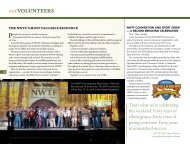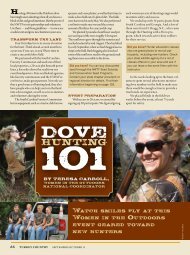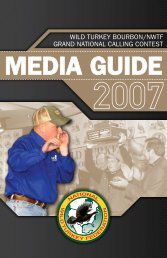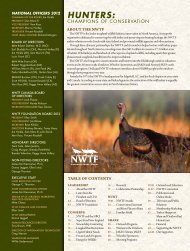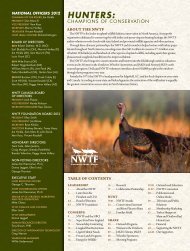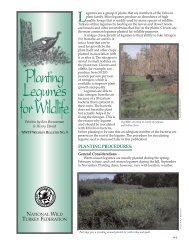Golden-Winged Warbler Initiative - National Wild Turkey Federation
Golden-Winged Warbler Initiative - National Wild Turkey Federation
Golden-Winged Warbler Initiative - National Wild Turkey Federation
Create successful ePaper yourself
Turn your PDF publications into a flip-book with our unique Google optimized e-Paper software.
ideal ruffed grouse nesting<br />
and feeding areas and the<br />
patches required by goldenwings<br />
are large enough to<br />
attract and support grouse.<br />
Sprinkling patches of young<br />
forest around in mature<br />
woods could potentially<br />
help ruffed grouse<br />
numbers increase.<br />
Forty to fifty years ago<br />
(unfortunately I am old<br />
enough to remember<br />
that far back) grouse<br />
were plentiful in coverts<br />
in the Poconos and what<br />
is now mature forest<br />
in the Pennsylvania<br />
<strong>Wild</strong>s. As our forests<br />
matured and fewer<br />
old fields and young<br />
forest was available,<br />
grouse numbers began<br />
to decline in parts<br />
of the state. Active<br />
management of our<br />
forests can have a<br />
positive impact on<br />
grouse and woodcock<br />
populations improving<br />
hunting for upland<br />
hunters who love to<br />
pursue these game<br />
birds. This new initiative<br />
has given the NWTF an<br />
opportunity to help other<br />
game birds by improving<br />
upland habitat. That of course<br />
is right on target with our<br />
conservation mission and our<br />
goal of preserving our hunting<br />
tradition.<br />
If the advantages for wild<br />
turkeys, woodcock and ruffed<br />
grouse were not enough to<br />
give credibility to this initiative<br />
in the eyes of dyed in the<br />
wool hunters, young forest<br />
is also preferred habitat for<br />
white-tails. The young forest<br />
preferred by golden-wings is<br />
excellent escape cover and<br />
foraging areas for deer. So if<br />
we are successful at finding<br />
landowners who would like<br />
to assist in developing better<br />
habitat for golden-winged<br />
warblers, the benefits reach<br />
far beyond these little world<br />
travelers. <strong>Golden</strong>-wings spend<br />
the spring and summer in the<br />
eastern United States and fly<br />
to Central and South America<br />
for the winter. The habitat<br />
they need for just two seasons<br />
of their year will be available<br />
to our non-migratory game<br />
species in all four seasons. It’s a<br />
win-win situation.<br />
In order to be successful<br />
we need your help. If you own<br />
property in any of the counties<br />
where golden-wings are found<br />
your land might be suitable for<br />
habitat work. Evaluating the<br />
area and developing habitat<br />
management plans specific to<br />
golden-winged warbler young<br />
The most productive habitat sites have a few mature trees,<br />
a number of saplings and shrubs and patches herbaceous cover<br />
like goldenrod and blackberry brambles per acre.<br />
panwtf.org<br />
forest habitat can be done<br />
by NWTF biologists at no<br />
cost to the landowner. This<br />
process will involve a site<br />
visit and plan preparation<br />
by the biologist. If the site is<br />
acceptable habitat work<br />
could be completed on a<br />
cost share basis with the<br />
NRCS paying most of<br />
the freight. Depending<br />
on the situation the<br />
landowner’s share<br />
might be covered by<br />
any timber harvest<br />
necessary to create the<br />
right conditions for<br />
developing golden-wing<br />
habitat. After the NWTF<br />
biologist develops a plan<br />
the landowner will need<br />
to apply to the NRCS<br />
to secure funding. That<br />
process involves visiting<br />
the NRCS office and<br />
completing the required<br />
forms.<br />
If you own land, have<br />
friends that own land,<br />
belong to a hunting<br />
clubs that owns land or<br />
know any landowners<br />
who might be interested<br />
in taking advantage of this<br />
opportunity, please contact<br />
the NWTF biologists working<br />
in Pennsylvania. There are<br />
two NWTF project biologists<br />
and one NWTF regional<br />
biologist available to assist<br />
through the Working Lands<br />
For <strong>Wild</strong>life <strong>Golden</strong>-winged<br />
<strong>Warbler</strong> <strong>Initiative</strong>. Our<br />
contact information can be<br />
found on the NWTF website<br />
or the Pennsylvania Chapter<br />
website. Brochures on the<br />
<strong>Golden</strong>-winged <strong>Warbler</strong><br />
<strong>Initiative</strong> containing our<br />
contact information are also<br />
available at Natural Resource<br />
Conservation Service offices.<br />
Remember that there is no<br />
cost for the consultation and<br />
plan development. This is a<br />
great chance to be involved<br />
in a major conservation effort<br />
that will benefit a wide range<br />
of wildlife species!<br />
Winter 2013 <strong>Turkey</strong> Talk<br />
7



